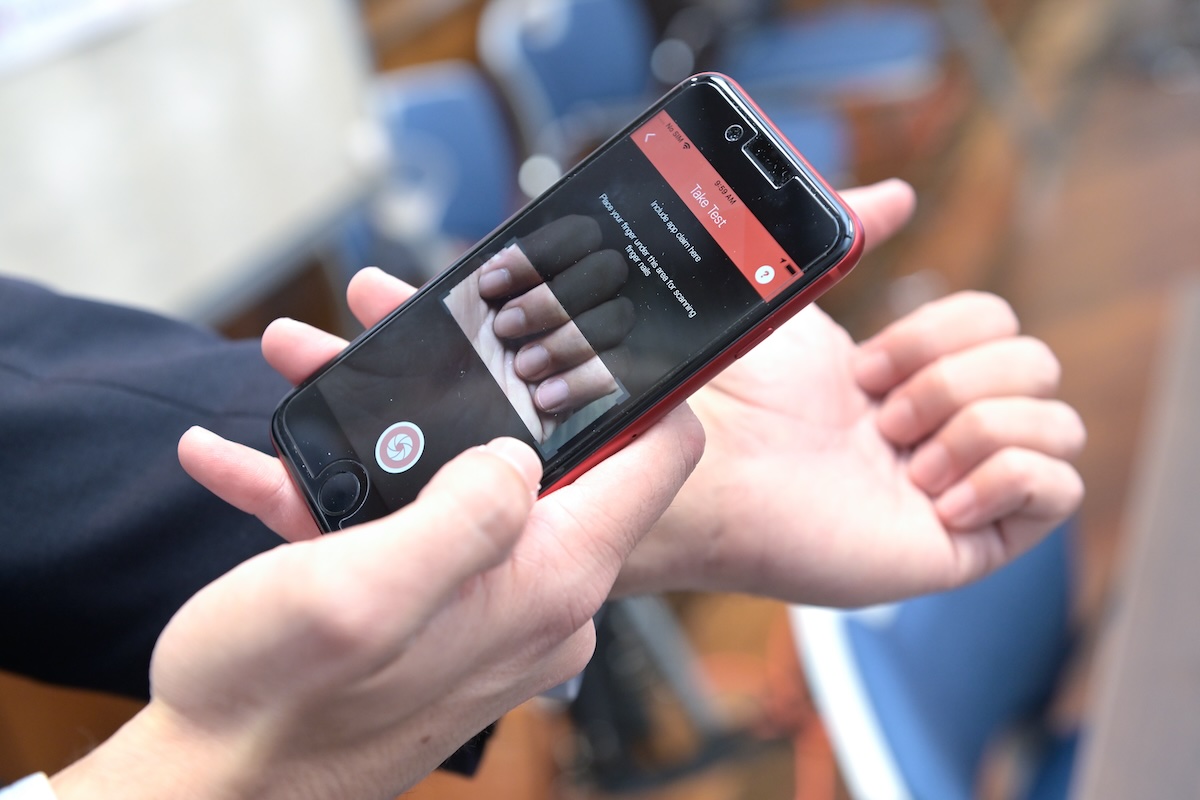Anemia is a chronic blood disorder affecting millions of people nationwide. Not only does it cause fatigue, weakness and shortness of breath, it’s also an indicator of generally poor health. Regular screenings for anemia can uncover more significant health problems, like colon cancer and kidney disease, but early diagnosis relies on access to care and blood testing.
Biomedical technology developed at Emory University and Georgia Tech is now changing the way people screen and monitor for anemia. Rather than a finger prick and drop of blood, the technology monitors for the disease in a completely non-invasive way with just a photo of a fingernail that can be uploaded to an app. An image of the fingernail is then assessed by the app where an abnormally pale fingernail indicates anemia.
A new paper published in Proceedings of the National Academy of Sciences (PNAS) shows promising results that the fingernail photo is just as accurate at screening and monitoring anemia as a blood sample. In real-world use across the U.S., the app amassed over 1.4 million uses of the tool. For users who compared their app results with blood tests, the app demonstrated strong performance — achieving 89% sensitivity and 93% specificity for anemia detection.

Wilbur Lam, MD, professor at Emory University and Georgia Tech and pediatric hematologist at Children’s Healthcare of Atlanta.
“From early signs of anemia to tracking trends that could help with life-threatening hemoglobin level drops, a photo of the fingernail was shown to be extremely accurate,” says Wilbur Lam, senior author on the paper, and professor at Emory University and Georgia Tech. “What makes the technology even more powerful is the AI-powered algorithm that automatically ‘zooms in’ on the fingernails of the photo the user just took and enables a more personalized medicine approach.”
The algorithm of the smartphone anemia app can also be customized to an individual patient if they have had blood counts already drawn. For example, patients with chronic anemia — either from iron deficiency, sickle cell disease or chronic kidney disease — often get their blood drawn at their clinical visits with their physicians.
In those cases, the patient’s clinical hemoglobin values can be entered into the app and used to calibrate the algorithm such that each patient has their own “personalized” algorithm, which increases the accuracy and precision for that specific patient.
Removing a critical barrier for effective anemia management, the app can also democratize anemia screening and monitoring by making it accessible at home without needles, potentially helping early detection and self-monitoring among patients with chronic diseases like kidney disease, especially in underserved communities.
Patients with limited access to clinics due to lack of transportation or other factors can conveniently test at home and receive results instantaneously. Plus, geotagged app data enabled public health mapping of hemoglobin levels across the U.S.
“For people with advanced diseases linked to anemia, screening tools can be critical for identifying and managing chronic disease earlier,” says Lam. “And with just a ‘fingernail selfie’, we make it even easier to screen. For a disease that affects two billion people worldwide, this is really a game changer, as anyone can screen or monitor their anemia anytime, anywhere and as frequently as they want without having to worry about getting stuck with a needle.”

The smartphone anemia app and technology are now licensed to Sanguina, a company that also offers another anemia technology, the AnemoCheck Home, which is the only FDA-cleared at-home anemia test kits that provide results in minutes with just a single drop of blood. Lam is also a co-founder and the chief medical officer for the company.
“As a medical device, this technology is part of this whole paradigm of non-invasive testing and especially testing with the smartphone, which is accessible to nearly everyone,” says Lam. “It’s also convenient. We hope that we can apply these same principals and monitoring for other diseases to ultimately improve public health.”
CITATION: Lam, Wilbur et al. Real-world implementation of a noninvasive, AI-augmented, anemia-screening smartphone app and personalization for hemoglobin level self-monitoring. PNAS. May 13, 2025.
Note: The Emory University Office of Research Compliance & Regulatory Affairs has implemented a robust Conflict of Interest set of management plans to ensure transparency and uphold the integrity of research activities associated with Sanguina for Dr. Wilbur Lam regarding their financial interest in the company. These measures are designed to mitigate potential conflicts of interest and maintain the highest standards of research integrity.

